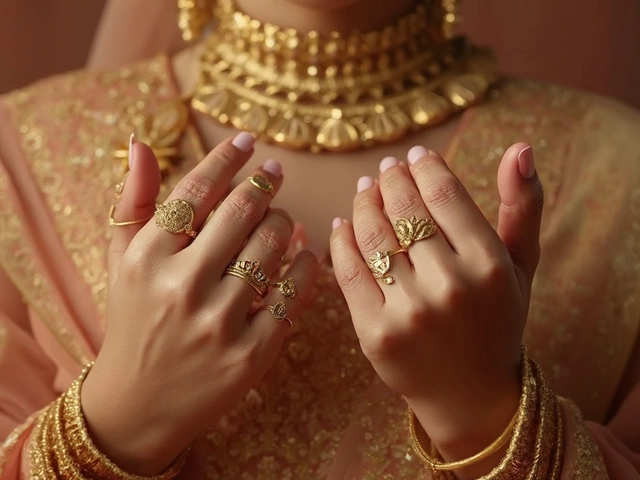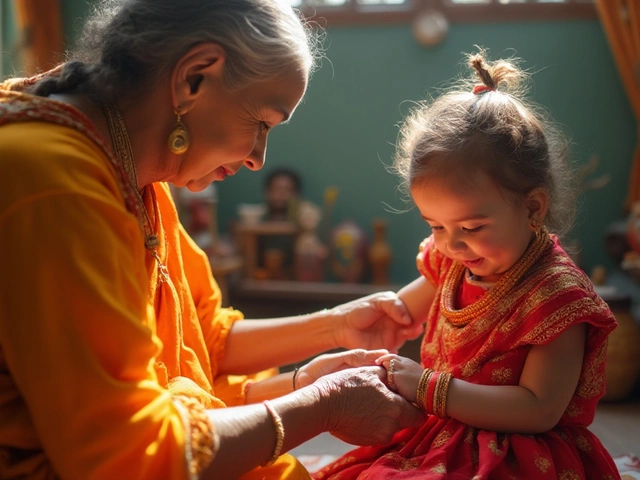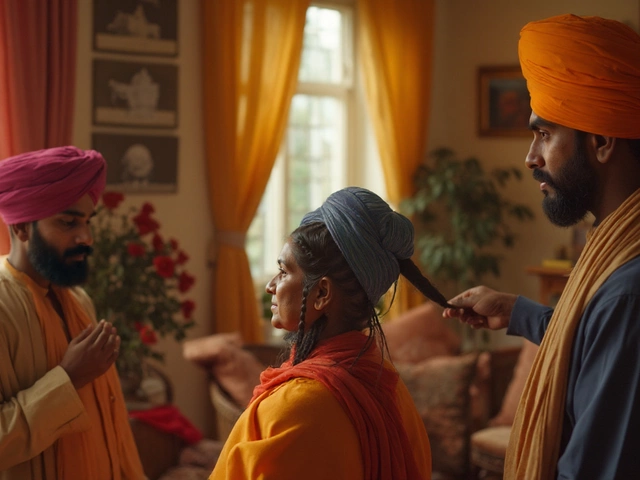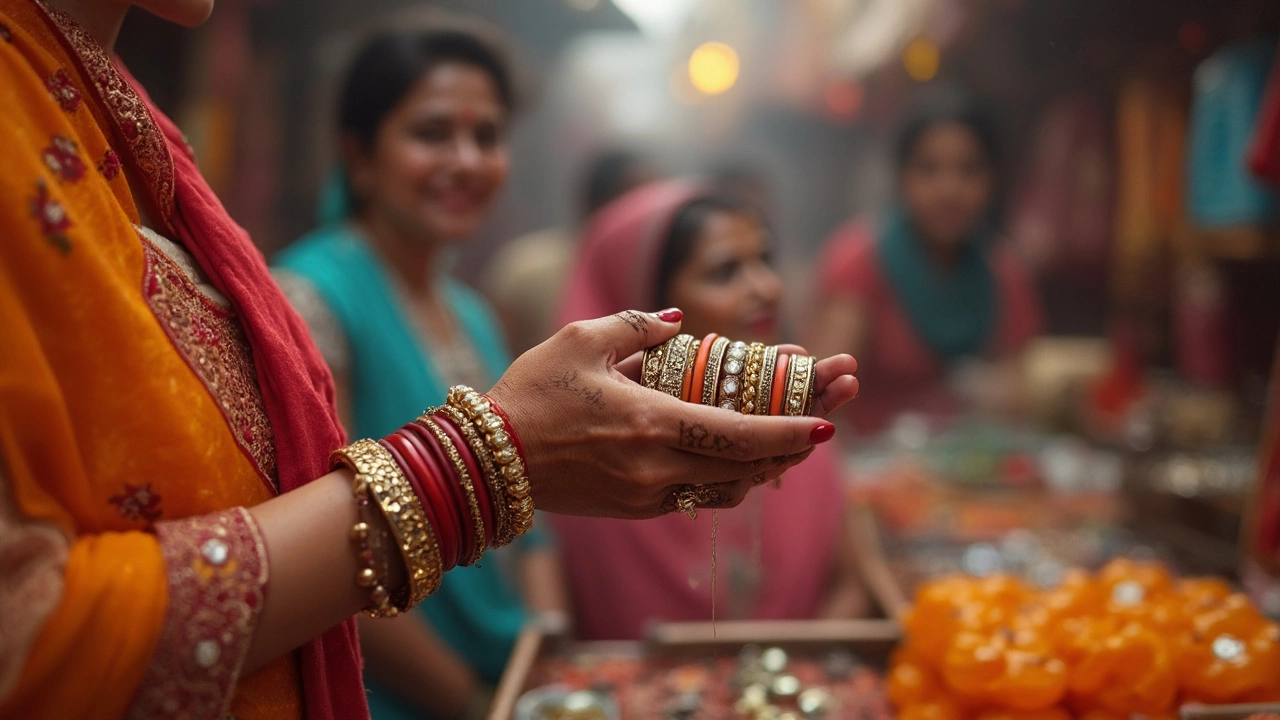
Bangles aren’t just fashion choices in India—they’re part of the everyday story of millions. For most Indian women, slipping on bangles is as normal as brushing teeth. But here’s the kicker: every single bangle can mean something, and it’s not just old-school tradition. Ask any bride, and she’ll tell you how bangles turn into emotional keepsakes, handpicked and passed down with actual tears and laughter.
Planning to visit India or getting invited to a wedding? Knowing a bit about bangles can be a shortcut to fitting in—or at least avoiding awkward stares. Colors, materials, and even which hand you wear them on have special rules. And hey, if you’re thinking of gifting bangles, don’t let Instagram fool you. Real bangles have stories and hidden dos and don’ts you need to know before you buy.
- Why Bangles Matter: Beyond Just Jewelry
- What Each Color and Material Means
- Bangles at Life’s Big Moments
- Tips for Wearing and Gifting Bangles
- Fun Facts and Modern Twists
Why Bangles Matter: Beyond Just Jewelry
Think bangles are just for show? In India, they’re serious business. Wearing traditional bangles is tangled up with beliefs about luck, love, and family. Walk through any Indian market, and you won’t just see people shopping for bangles—they’re choosing connection, history, and tradition. From childhood to old age, bangles mark life’s stages.
Back in the day, bangles didn’t just look good—people thought they brought good health. Some say a silver or copper bangle helps blood flow because of the way it touches your wrist. Science aside, it’s true: glass bangles often break if there’s a sudden impact, and folks have taken this as a sign to pay attention to their body or surroundings.
Bangles are loaded with meaning. For married women, they symbolize a long, happy marriage. In Punjab, you’ll see brides rock white and red bangles called chooda for good luck. Down south, gold bangles mean status and stability, passed down from grandma to mom to daughter. In some families, these are as important as the wedding ring.
"A woman’s bangles are not just ornaments. They are a symbol of her identity and status," notes Dr. Rekha Jain, historian at Delhi University.
Even where you wear them counts—tradition says both arms, but there are regional quirks (in Bengal, breaking the iron bangle after widowhood is a big deal). Little girls start with plastic or glass bangles. As they grow, the bangle size, style, and material change to match each big milestone.
| Region | Significance | Popular Material |
|---|---|---|
| Punjab | Marriage luck (chooda) | Ivory, plastic |
| Bengal | Marital status (shakha pola) | Conch shell, coral |
| South India | Family wealth | Gold |
| Maharashtra | Health, tradition | Green glass |
It’s easy to miss just how much bangles matter until you see a whole family swap stories over a pile of old glass bracelets. So, if you’re ever handed a set, know you’re getting a slice of real Indian life—not just an accessory.
What Each Color and Material Means
Grab a handful of bangles in any Indian market, and you’ll see a rainbow. But these colors aren’t picked at random. They actually mean things, from love and luck to new beginnings. Let’s break it down, because when it comes to traditional bangles, the right choice tells a story.
First up—colors matter a lot:
- Red: All about energy and marriage. North Indian brides usually stack up on red glass bangles after their wedding and wear them for months. It’s seen as super lucky.
- Green: Shows fertility and good luck. It’s a top pick for married women in Maharashtra and Bengal, especially during festivals and family events.
- Yellow: Sign of happiness, new beginnings, and sometimes used in baby showers.
- White: Symbolizes purity. In some communities (like in Punjab), white bangles made from ivory (called 'chooda') are given to brides.
- Blue and Black: Usually worn less, but sometimes used to ward off the evil eye.
Materials are another biggie. Glass, gold, metal, lac, ivory—each has its purpose and place:
- Glass: Popular and affordable. The sound of glass bangles clinking is believed to spread positivity at home. Some women won’t remove them unless absolutely necessary.
- Gold: Seen as a status symbol. South Indian brides often get gold bangles as wedding gifts, sometimes passed down through families for generations.
- Lac (a kind of resin): Big in Rajasthan. These are colorful and flexible, worn for festivals and special occasions.
- Ivory and plastic: We rarely see ivory now due to wildlife laws, but plastic has stepped in as a budget-friendly alternative.
If you look across states, tradition can be even stricter. For example, Bengali brides wear shakha (white) and pola (red) bangles made from conch shell and coral respectively, seen as a sign of married life. In Gujarat, women choose green glass bangles for fertility, especially after marriage.
| Region | Color/Material | Meaning |
|---|---|---|
| Punjab | Ivory/White (Chooda) | Marriage, newlywed luck |
| Bengal | Shakha (White)/Pola (Red) | Married status, prosperity |
| Maharashtra | Green Glass | Fertility, married life |
| South India | Gold | Wealth, family status |
| Rajasthan | Lac | Festive spirit, tradition |
If you’re buying bangles as a gift, find out what colors are right for that person’s background or occasion. Getting the wrong color or material isn’t just a style miss—it can feel like you missed the deeper meaning.
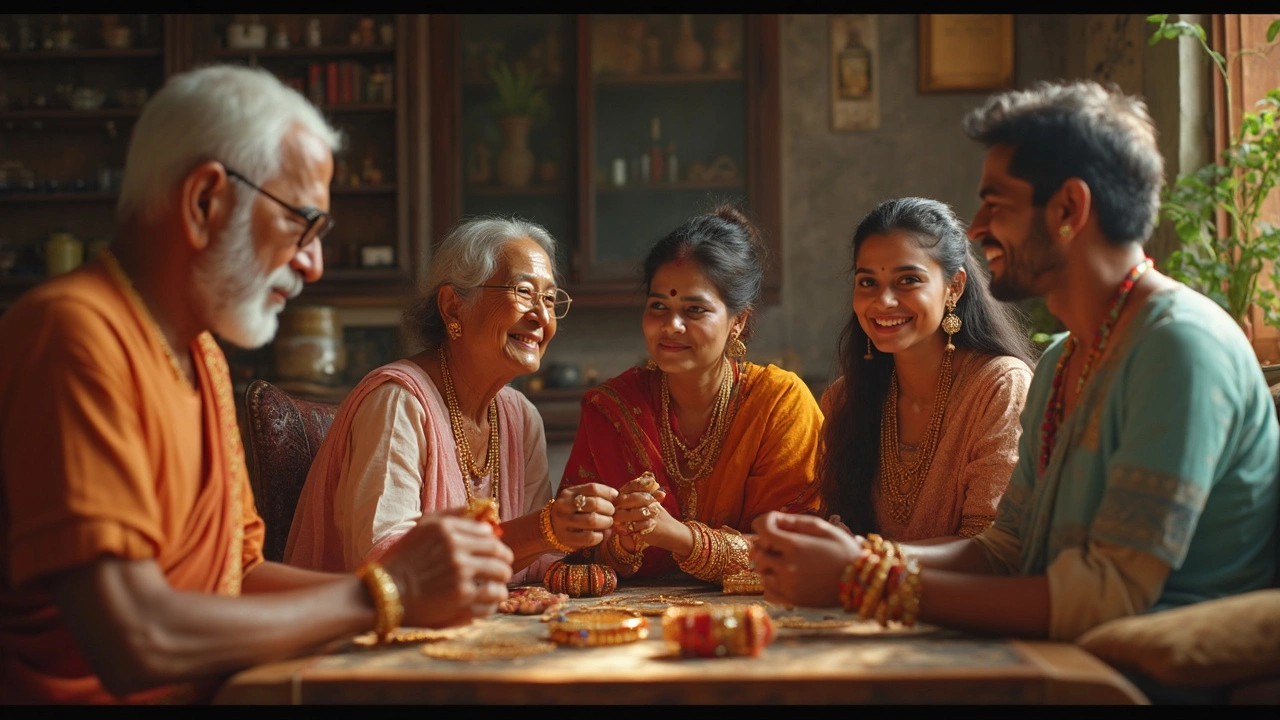
Bangles at Life’s Big Moments
Bangles aren’t just for show or everyday style in India—they’re locked into pretty much every major life event, from your first day out of the hospital to your wedding and beyond. Let’s break down the key spots where these circles of color really matter.
- Birth and Childhood: Literally, your first pieces of jewelry as a baby will almost always be bangles. In South India, there’s even a special ceremony called “Valaikaappu” (bangle ceremony) when a woman is pregnant, usually in her seventh month. Friends and family load her arms with glass bangles because they believe the sound helps both mom and baby stay happy and healthy.
- Coming of Age: In some parts of India—like Andhra Pradesh and Tamil Nadu—girls get their first set of traditional glass bangles at puberty. It’s not about fashion, but a signal to the community that a girl has reached a new stage of life.
- Weddings: Now here’s where things get serious. At an Indian wedding, no accessory gets as much attention as the bride’s traditional bangles. Take the Punjabi “chooda” – that’s a set of 21 (sometimes more) white and red bangles gifted by her uncle. The bride must wear them for a minimum of 40 days after the wedding. In Maharashtra, green glass bangles are a must, symbolizing fertility and luck. Bengali weddings have “shakha pola”—white conch shell and red coral bangles married women are supposed to wear, sometimes for life.
- First Festivals After Marriage: During big festivals like Karva Chauth (a festival for married women), Diwali, or Teej, new brides show off their wedding bangles as a sign of newlywed status and good fortune. Even after years of marriage, wearing bangles during these times is seen as lucky.
- Widowhood: In some traditional communities, widows break their glass bangles in a quiet ceremony—sometimes the very next day after the husband’s passing—as a symbol of the end of married life.
Here’s a rough look at how often bangles show up in these moments across India’s biggest regions:
| Life Stage/Event | Bangle Tradition | Common Materials | Region |
|---|---|---|---|
| Pregnancy (Valaikaappu) | Stacking glass bangles | Glass | South India |
| Marriage/Wedding | Set of chooda, green glass, or shakha pola | Ivory, Plastic, Glass, Conch/Coral | Panjab, Maharashtra, Bengal |
| Puberty/Coming of Age | First bangle set gifted | Glass, Metal | South India |
| Widowhood | Bangles broken/removed | Glass | North, East India |
The fun part? Even today, these traditions are alive in both city apartments and tiny rural homes. If you ever get invited to a bangle ceremony, go—it’s loud, up-close, and filled with emotion. And don’t worry if you can’t keep track of which color means what. Just being part of it is what everyone remembers.
Tips for Wearing and Gifting Bangles
If you’re tackling the world of traditional bangles, a little know-how goes a long way. First up, bangles come in all sorts of materials—glass, gold, silver, lac, plastic. But here’s the thing: glass is big for married women, especially in places like Maharashtra and Bengal. Gold bangles (also called kadas) often scream "special occasion" and are usually gifted in weddings or festive settings.
Fit is everything. Bangles shouldn’t be so tight that your hands turn red, and you should be able to slide them on and off without a struggle. Most people use a dab of moisturizer or even a plastic bag on the hand to help stubborn ones slide. If you’re shopping at a local market, the seller will probably have a wooden or metal rod to help you test the size.
Mixing bangles is actually encouraged. A stack of glass, a couple of metal ones, and a standout gold piece? Go for it—just watch the color combos. Red and green mean you’re married in northern India. In southern states, green alone is considered super lucky for brides.
- If you’re gifting bangles, find out the wearer’s size first. No one wants pretty bangles that just gather dust because they don’t fit.
- Packing matters! In India, bangles are usually given in decorative boxes or trays, sometimes wrapped in silk or velvet.
- For close friends or family, gold or silver bangles are seen as a thoughtful, lasting gift, especially at weddings or major festivals.
- If you’re joining a pre-wedding function, glass bangles in sets of 24 or 48 are a traditional and safe bet.
If you break a bangle by accident, don’t panic. In many places, it's seen as a sign to move on from the past, especially after a bad patch or illness. Still, if you hear a bangle breaking at a wedding, quietly swap it for a new one so the celebration vibe stays positive.
One last thing: cheap plastic bangles look great for one-off events or little kids but can come off as odd for major occasions. Stick with glass or metal for grown-ups when it counts.
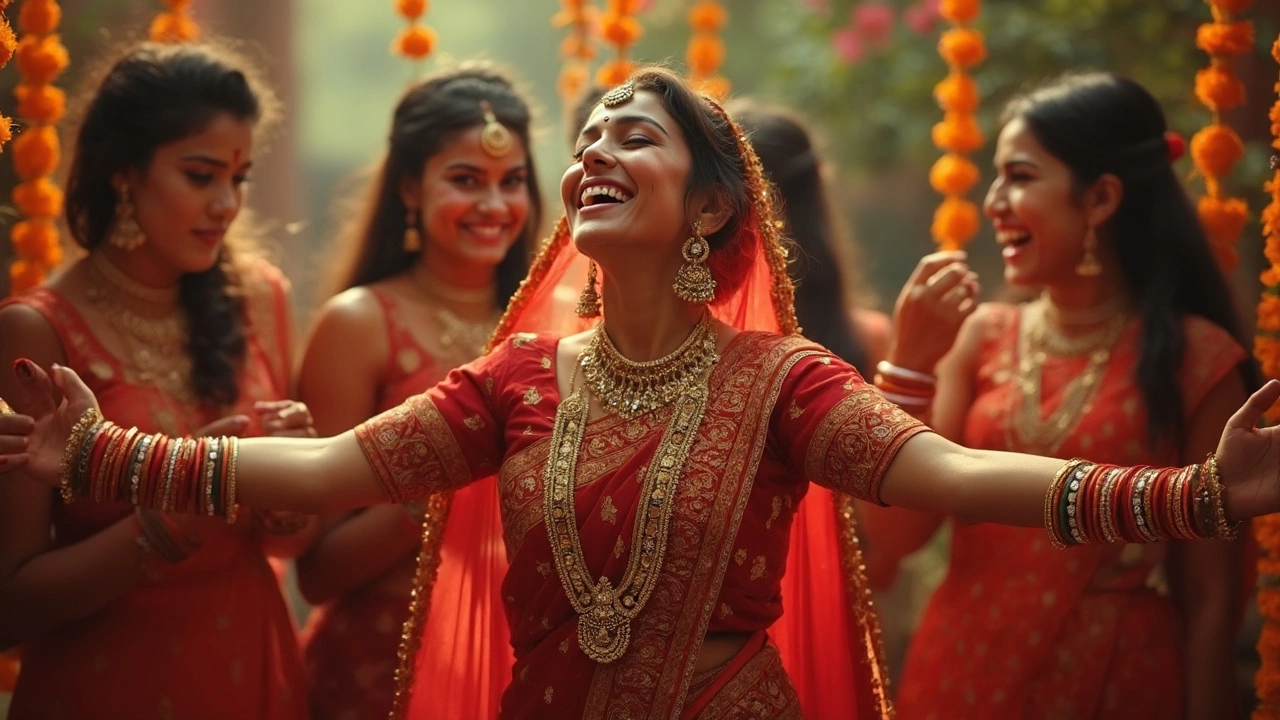
Fun Facts and Modern Twists
Think bangles haven’t changed? Not even close. What started as simple glass or metal circles is now a global fashion craze. Designers add everything from LED lights to fingerprint sensors. Bollywood stars like Deepika Padukone and Priyanka Chopra have rocked bangles on the red carpet, making them cool beyond just tradition.
Here’s something wild: Guess how old the oldest found Indian bangle is? Archaeologists dug up a shell bangle in Gujarat from around 2,600 BC—almost 4,500 years old! That puts bangles up there with the earliest jewelry on earth.
Check out these fun and surprising facts about traditional bangles in India:
- Glass bangles from Hyderabad can make up to 11 different sounds, each linked to different moods.
- Red and green bangles sold out in North India after famous TV weddings—actual stores had waiting lists for the most popular colors.
- Some tech brands have made "smart bangles" that count your steps or show phone alerts—you’d spot them in Mumbai offices and gyms.
- In Maharashtra, iron green ('patli') bangles are a must-have for new brides, with some families gifting dozens at once.
- The annual Laad Bazaar in Hyderabad sells over 30,000 pairs of bangles during festival weeks alone.
Take a look at this quick stats table for just how big bangles really are in India:
| Fact | Number/Data |
|---|---|
| Estimated Indian bangle market (2024) | $1.2 billion USD |
| Average number of bangles owned per woman (urban areas) | 40+ |
| States most famous for bangle making | Uttar Pradesh, West Bengal, Rajasthan, Telangana |
| Most popular bangle festival | Teej and Diwali |
After all these years, bangles aren’t just surviving—they’re getting cooler. From wedding trousseaus to gym wear, bangles can be traditional, modern, and even smart. Whether you want a piece of culture or a fashion-forward look, bangles can do both without missing a beat.
